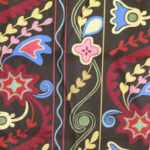Born in Moradabad on 6 May, 1968, ReenaSinghal(an eminent Textile Designer and a proficient teacher at Raja Ram Mohan Roy Academy Dehradun) tied her knots to Alok Singhal in the year 1987 and shifted to Dehradun. Full of colossal talent, the lady is even the master of paper art involving paper jewelry. Having worked for an export house USA, she has entranced many with her miraculous talent.
While interacting with Kanchan Negi, she unfolded the gravity of textile designing as a career.
The excerpts of the interview are as follows:

“Textile designing is a paramount career to opt for. I personally feel that textile designing proffers innumerable employment opportunities to individuals with an eye for detail and a knack for designing. It not only provides for one of the most basic physiological needs of the people in the country, but is also responsible for enormous economic development. According to the Government of India’s website – www.india.gov.in – it is one of the most capital and labor intensive industry that contributes four per cent to the country’s GDP and 13.5 per cent to the annual export earnings. Undoubtedly it is the second largest employer after the agricultural sector, employing 35 million people directly.”
She added, “India’s rich and varied heritage of textiles makes a career in textile design an exciting proposition. Textile design refers to the art of process of designing the different structures and looks of different textiles, or fabrics. Although they may seem quite similar to the untrained eye, the majority of textiles have quite a few different characteristics. Some textiles may be made from a single type or a blend of natural or synthetic fibers. These fibers are also usually fused together differently. Some are woven together, while others may be knitted together.”
While explaining about the textiles she continued, “Textiles come in a wide range of different colors and patterns, and it is also the textile designer’s job to determine what type of design a certain fabric should have, and how that look will be achieved. Prints on fabrics can be created with dye or screen printing, or they can be created by using different colored fibers when the fabric is being woven or knitted together.”
On being questioned that what exactly a textile designer does, she replied, “The job of a textile designer is to help create the structure and design of different types of textiles. These textiles may be used to create garments, accessories, bedding, furniture, window treatments, and a variety of other common everyday items. Textile designers usually work closely with other types of designers, like fashion designers or interior designers in an effort to create the perfect pattern.
Before a textile designer starts to design a fabric, he first needs to know what the fabric will be used for. This will help him/her to choose the right type of fabric, as well as the right sort of pattern. For example, furniture fabrics will usually have different properties and designs than fabrics being used to make blouses. I personally live in a web of ideas, a fabric of my own making.” (smile)
Thus, it can clearly be seen that textile designers need to understand fabrics, behaviors and properties extremely well. They also need to possess a good sense of the visual and design principles like color, composition, patterns, etc. Weaving forms a very important part of textiles and the textile designing course includes a module that introduces students to various weaving methods so that they can experiment and create new weaves.